Schrödinger Bundle
Who Really Owns Schrödinger?
Ever wondered who truly steers the ship at Schrödinger, the innovative force behind physics-based computational platforms? Understanding a company's ownership is crucial, especially when it's a publicly traded entity like Schrödinger Inc., revolutionizing drug discovery and materials science. The ownership structure dictates everything from strategic decisions to long-term growth, making it a critical factor for investors and stakeholders alike.
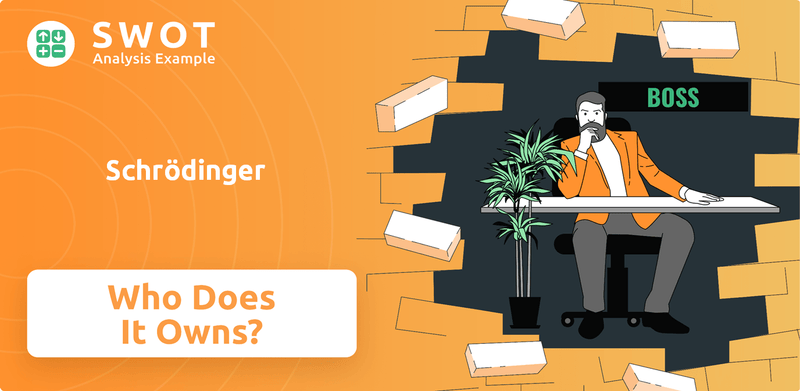
From its humble beginnings in 1990 to its current status as a major player in the pharmaceutical and biotechnology sectors, Schrödinger's journey is a fascinating case study in corporate evolution. This exploration will uncover the intricate details of Schrödinger SWOT Analysis, its ownership, and how it has shaped the company's trajectory. Discover the influence of key institutional investors, the impact of public shareholders, and the overall dynamics of Schrödinger's leadership and its stock.
Who Founded Schrödinger?
The company, Schrödinger Inc., was established in 1990. Its founders were Richard Friesner, a chemistry professor from Columbia University, and William Goddard, a chemistry and materials science professor at Caltech. Their initial vision was to transform complex theoretical physics into practical tools for drug discovery and materials science, which set the stage for the company's future in computational chemistry.
The early ownership structure of Schrödinger reflected this scientific collaboration and entrepreneurial spirit. While specific equity splits at the beginning are not publicly detailed, it's clear that the founders played a pivotal role in shaping the company's direction. The company's early days involved translating complex scientific concepts into practical applications, a process that likely involved the founders' initial investments and potentially support from early backers.
In the early stages, agreements such as vesting schedules and buy-sell clauses were critical for aligning the founders' and any early investors' interests. These agreements ensured commitment and provided mechanisms for future liquidity or transitions. The initial distribution of control directly reflected the founding team's vision for the company's scientific and commercial direction. The core principle driving early ownership was to maintain a strong scientific foundation while building a viable commercial entity.
The early ownership of Schrödinger, a key aspect of understanding who owns Schrödinger, involved several critical elements. The founders, Richard Friesner and William Goddard, likely held significant equity. Early investment rounds would have brought in additional shareholders, including angel investors or venture capital firms. Understanding the initial ownership structure is crucial for tracing the company's evolution and the influence of its key stakeholders. The company's early focus was on commercializing advanced computational chemistry methods, which required significant investment in research and development.
- The founders, Richard Friesner and William Goddard, played pivotal roles.
- Early investments likely came from angel investors and venture capital.
- Agreements like vesting schedules were crucial for aligning interests.
- The initial ownership structure set the stage for the company's scientific and commercial direction.
Schrödinger SWOT Analysis
- Complete SWOT Breakdown
- Fully Customizable
- Editable in Excel & Word
- Professional Formatting
- Investor-Ready Format
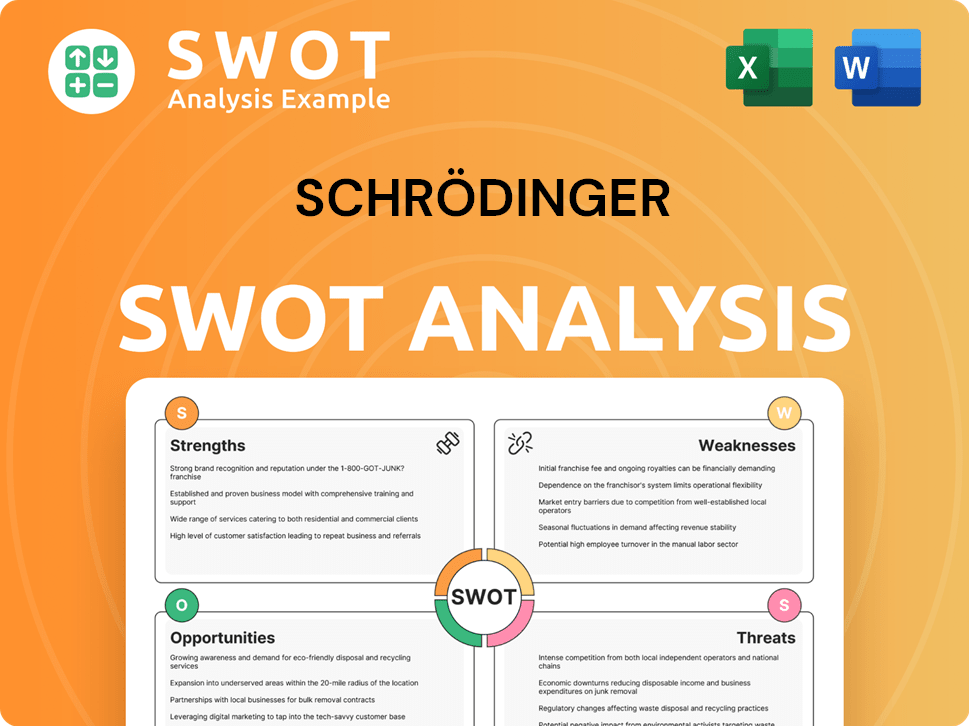
How Has Schrödinger’s Ownership Changed Over Time?
The evolution of Schrödinger's ownership structure is marked by a significant transition from a privately held entity to a publicly traded company. This shift occurred on February 5, 2020, when the company launched its Initial Public Offering (IPO) on the Nasdaq Global Select Market, trading under the ticker symbol 'SDGR.' This event broadened the ownership base, moving beyond the founders and early investors to include a wider array of shareholders.
Following the IPO, the ownership of Schrödinger has become more diversified. Major shareholders now include institutional investors, mutual funds, index funds, and individual insiders. As of early 2025, institutional ownership holds a significant portion of the company's shares. Key institutional investors often include large asset management firms, hedge funds, and investment banks. Understanding the dynamics of Schrödinger company ownership is crucial for anyone interested in the company's financial health and strategic direction. The company's market capitalization at the time of the IPO reflected the market's confidence in its drug discovery platform and growth potential.
| Event | Date | Impact on Ownership |
|---|---|---|
| IPO | February 5, 2020 | Transitioned from private to public; expanded shareholder base. |
| Subsequent Stock Offerings | Ongoing | Further dilution of ownership; potential shifts in major shareholders. |
| Institutional Investor Activity | Ongoing | Changes in holdings by major investors can influence company strategy and governance. |
The most recent Securities and Exchange Commission (SEC) filings, such as the 10-K for the fiscal year ending December 31, 2024, and subsequent quarterly reports, provide detailed information on the precise percentages held by major stakeholders. These filings also reveal holdings of significant individual shareholders, including founders and executive officers. Changes in holdings by large institutional investors can influence company strategy and governance. For more insights into the company's strategic direction, consider reading about the Growth Strategy of Schrödinger.
Schrödinger transitioned from a private to a public company through its IPO in 2020.
- Institutional investors hold a substantial portion of the company's shares.
- Major shareholders include asset management firms and hedge funds.
- SEC filings provide detailed information on ownership percentages.
- Changes in ownership can influence company strategy and governance.
Schrödinger PESTLE Analysis
- Covers All 6 PESTLE Categories
- No Research Needed – Save Hours of Work
- Built by Experts, Trusted by Consultants
- Instant Download, Ready to Use
- 100% Editable, Fully Customizable
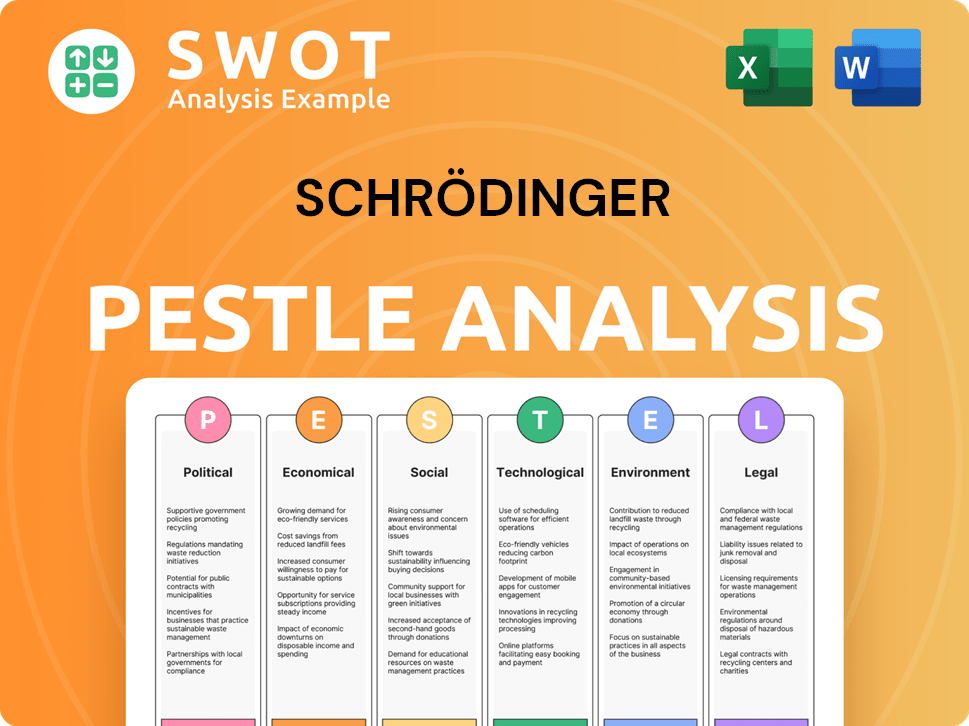
Who Sits on Schrödinger’s Board?
The Board of Directors of the Schrödinger company plays a crucial role in overseeing the company's strategic direction and governance, representing the interests of its diverse shareholder base. As of the most recent disclosures, the board includes a mix of individuals representing major shareholders, founders, and independent directors. To find the most current board composition, consult the latest proxy statements (DEF 14A filings) or the company's investor relations website. The board typically includes key executives such as the CEO, co-founders, and independent directors with relevant industry or financial expertise. Understanding the Target Market of Schrödinger can provide further context on the board's strategic focus.
The voting structure for Schrödinger follows a one-share-one-vote principle for its common stock, which is standard for many publicly traded companies. This means that each share of common stock held by an investor grants them one vote on matters presented to shareholders, such as the election of directors or approval of corporate actions. There is no public indication of dual-class shares, special voting rights, or golden shares that would grant outsized control to specific individuals or entities beyond their proportional shareholding. This structure is crucial for understanding Schrödinger company ownership and the influence of Schrödinger investors.
| Board Member | Title | Affiliation |
|---|---|---|
| Ramy Farid, Ph.D. | Chairman of the Board, CEO | Schrödinger |
| Karen A. Acker | Independent Director | Former CFO, MilliporeSigma |
| David E. Shaw, Ph.D. | Director | D. E. Shaw Research |
While specific proxy battles or activist investor campaigns against Schrödinger have not been prominently reported in recent years (2024-2025), the general landscape of public companies often involves such dynamics. The board's composition reflects the balance between maintaining the founders' vision, integrating the expertise of independent directors, and acknowledging the influence of major institutional investors. Any significant shifts in ownership, particularly by large activist funds, could lead to changes in board composition as shareholders seek to align governance with their investment objectives. The current Schrödinger leadership team is focused on driving innovation and growth within the company.
The board's composition and the one-share-one-vote structure are key to understanding who owns Schrödinger and how decisions are made. The board oversees strategic direction and ensures alignment with shareholder interests. Key factors include:
- One-share-one-vote principle ensures proportional voting power.
- Board includes founders, major shareholders, and independent directors.
- Changes in ownership can influence board composition.
- Understanding the board is crucial for Schrödinger stock analysis.
Schrödinger Business Model Canvas
- Complete 9-Block Business Model Canvas
- Effortlessly Communicate Your Business Strategy
- Investor-Ready BMC Format
- 100% Editable and Customizable
- Clear and Structured Layout
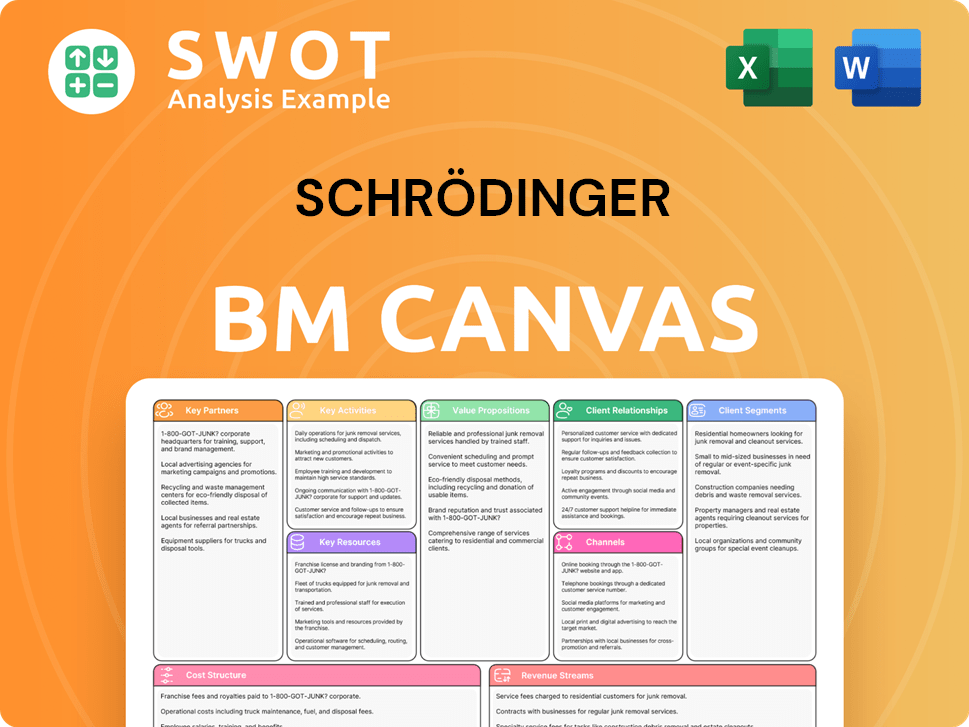
What Recent Changes Have Shaped Schrödinger’s Ownership Landscape?
Over the past few years, the ownership structure of Schrödinger Inc. has been shaped by typical market dynamics. As a publicly traded entity, its ownership is subject to shifts in institutional investment strategies and broader industry trends. While specific large-scale events like major share buybacks or secondary offerings may not have been announced recently, routine trading by institutional investors constantly adjusts the ownership landscape. This includes the ongoing evolution of institutional holdings, which is detailed in their investor presentations and financial reports.
The biotechnology and software sectors have seen a rise in institutional ownership. Founder dilution is a natural consequence of going public and subsequent capital raises, where the founders' proportional ownership decreases as new shares are issued to a wider investor base. However, founders often retain significant influence through their continued involvement in leadership roles. Mergers and acquisitions within the pharmaceutical and technology sectors can also indirectly impact Schrödinger's competitive landscape. Leadership or founder departures, while not explicitly reported as drastically impacting ownership structure for Schrödinger recently, are always significant events that can shift investor confidence.
| Metric | Value | Source/Date |
|---|---|---|
| Stock Symbol | SDGR | Nasdaq |
| Market Capitalization (Approx.) | Around $2.5 billion | Market Data, October 2024 |
| Institutional Ownership (Approx.) | Around 80% | Market Data, October 2024 |
The Growth Strategy of Schrödinger involves strategic partnerships and collaborations, which contribute to its market position and investor appeal. Public statements from the company or analysts regarding future ownership changes, such as potential secondary offerings to fund growth initiatives, would be detailed in their investor presentations and financial reports. For investors looking to understand the ownership of Schrödinger, monitoring these reports and market data is essential.
The stock price history of Schrödinger has fluctuated, reflecting market sentiment and company performance. Investors should review the latest financial reports and analyst ratings for the most current data. Understanding the stock's performance is crucial for making informed investment decisions.
Major shareholders in Schrödinger include institutional investors. Detailed information about the largest shareholders is available in the company's SEC filings. These filings provide a comprehensive view of the company's ownership structure.
The leadership of Schrödinger plays a critical role in shaping the company's direction. Key executives and their roles are detailed in the company's annual reports and investor presentations. Leadership changes can impact investor confidence.
Investing in Schrödinger, a public company, involves buying its stock through a brokerage account. Investors should research the company's financials and market position before investing. Consulting with a financial advisor is recommended.
Schrödinger Porter's Five Forces Analysis
- Covers All 5 Competitive Forces in Detail
- Structured for Consultants, Students, and Founders
- 100% Editable in Microsoft Word & Excel
- Instant Digital Download – Use Immediately
- Compatible with Mac & PC – Fully Unlocked
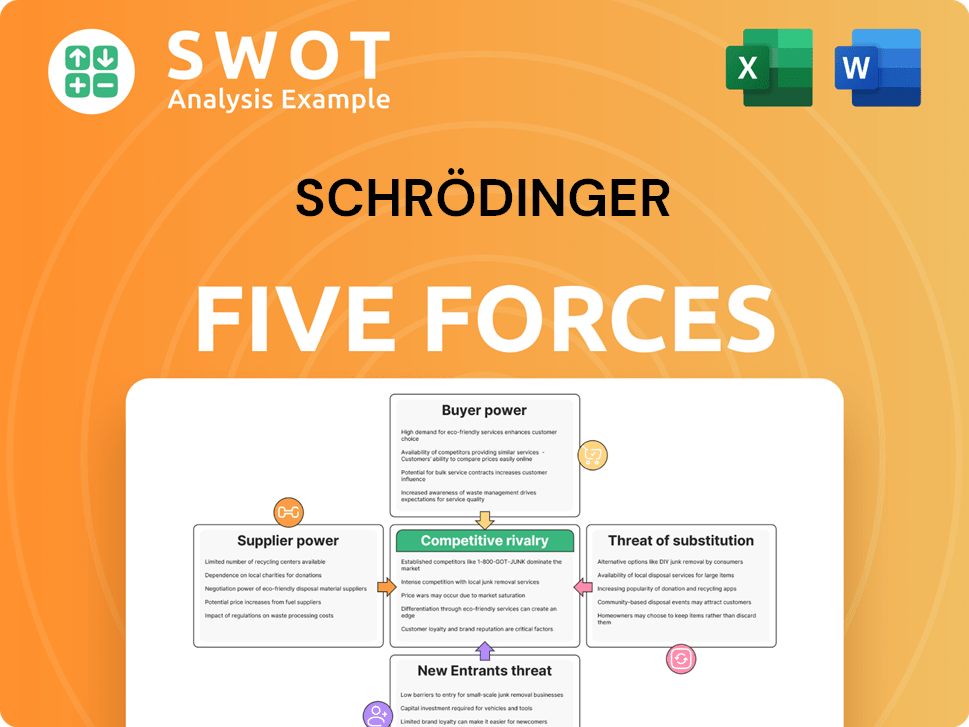
Related Blogs
- What are Mission Vision & Core Values of Schrödinger Company?
- What is Competitive Landscape of Schrödinger Company?
- What is Growth Strategy and Future Prospects of Schrödinger Company?
- How Does Schrödinger Company Work?
- What is Sales and Marketing Strategy of Schrödinger Company?
- What is Brief History of Schrödinger Company?
- What is Customer Demographics and Target Market of Schrödinger Company?
Disclaimer
All information, articles, and product details provided on this website are for general informational and educational purposes only. We do not claim any ownership over, nor do we intend to infringe upon, any trademarks, copyrights, logos, brand names, or other intellectual property mentioned or depicted on this site. Such intellectual property remains the property of its respective owners, and any references here are made solely for identification or informational purposes, without implying any affiliation, endorsement, or partnership.
We make no representations or warranties, express or implied, regarding the accuracy, completeness, or suitability of any content or products presented. Nothing on this website should be construed as legal, tax, investment, financial, medical, or other professional advice. In addition, no part of this site—including articles or product references—constitutes a solicitation, recommendation, endorsement, advertisement, or offer to buy or sell any securities, franchises, or other financial instruments, particularly in jurisdictions where such activity would be unlawful.
All content is of a general nature and may not address the specific circumstances of any individual or entity. It is not a substitute for professional advice or services. Any actions you take based on the information provided here are strictly at your own risk. You accept full responsibility for any decisions or outcomes arising from your use of this website and agree to release us from any liability in connection with your use of, or reliance upon, the content or products found herein.